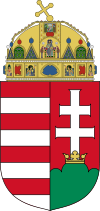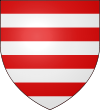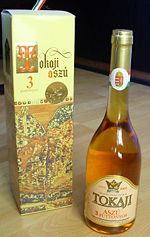- National symbols of Hungary
-
The national symbols of Hungary are flags, icons or cultural expressions that are emblematic, representative or otherwise characteristic of Hungary or Hungarian culture. Additionally, highly valued special Hungarian products, symbols have a special name, those can be called Hungaricum.[1]
Contents
Flags and heraldy
Main article: Flags of Hungarian historyThe flag of Hungary is a horizontal tricolour of red, white and green. The coat of arms of the Árpád dynasty is also popular.

Flora and fauna
Almost a fifth of the country is forested, however only 10 percent is natural forest.[2] Hungary is home to some 2200 flowering plant species and, because of its topography and transitional climate, many of them are not normally found at this latitude. Much of the flora in the Villány and Mecsek Hills in Southern Transdanubia, for example, is usually seen only around Mediterranean.[2] Here, at the southern Szársomlyó Hill of Villány Mountains, a formerly unknown plant was found and described for science in 1867 by the Hungarian botanist, Viktor Janka. This flower is the earliest blooming Hungarian flower, the Hungarian crocus, Colchicum hungaricum.
The salty Hortobágy region on the Eastern Plain has many plants normally found by the seashore, and the Nyírség area is famous for meadow flowers. The Gemenc forest on the Danube near Szekszárd, the Little Balaton in the centre of Transdanubia and the Tisza river backwater east of Kecskemét are all important wetlands.[2] Most of the trees in the nation's forested areas are deciduous (beech, oak and birch) only a small percentage are fir. Since the 14th century, over 250 new plants colonized Hungary, of which almost 70 are considered invasive.[2] Many such plants are perennial herbs, that have taken root on plants, causing some of the native flora to slowly disappear.[2]Historically, Hungary was the second largest supplier of paprika to the USA.[3] Hungarian paprika has a distinctive flavour and is it great demand in Europe where it is used as a spice rather than as a colouring agent.[3]
People
Food and drink
See also: Hungarian beerThe traditional Hungarian dishes abound in piquant flavors and aromas.[4] Dishes are flavorful, spicy and often rather heavy. Flavors of Hungarian dishes are based on centuries-old traditions in spicing and preparation methods.[4] The exquisite ingredients are produced by local agricultural and husbandry. Paprika, onion and garlic are to be found everywhere. In the Middle Ages the fish soup was the most popular and the most lovely fishmeal in Hungary.[4] A cookery book from 1860 contains 400 fish recipes.[4] The most well-known specialities of Hungarian cuisine such as goulash soup, the different varieties of stew and "paprikas" are red with paprika.[4]
See also
- Hungary
- List of Hungarian dishes
- National Historical Memorial Park of Ópusztaszer
References
- ^ International Plant Genetic Resources Institute, Report of a Working Group on Medicinal and Aromatic plants: first meeting 12-14 September 2002, Gozd Martuljek, Slovenia, 2004, p. 46
- ^ a b c d e Neal Bedford, Lonely Planet Hungary, Lonely Planet, 2009, p. 64
- ^ a b Niir Board,Handbook On Spices (Reprint Edition - 2010), National Institute Of Industrial Re, 2010, p. 101
- ^ a b c d e Teresa de Noronha Vaz, Peter Nijkamp, Jean-Louis Rastoin, Traditional food production and rural sustainable development: a European challenge, Ashgate Publishing, Ltd., 2009, p. 106
Bibliography
National symbols of Europe Sovereign
states- Albania
- Andorra
- Armenia
- Austria
- Azerbaijan
- Belarus
- Belgium
- Bosnia and Herzegovina
- Bulgaria
- Croatia
- Cyprus
- Czech Republic
- Denmark
- Estonia
- Finland
- France
- Georgia
- Germany
- Greece
- Hungary
- Iceland
- Ireland
- Italy
- Kazakhstan
- Latvia
- Liechtenstein
- Lithuania
- Luxembourg
- Macedonia
- Malta
- Moldova
- Monaco
- Montenegro
- Netherlands
- Norway
- Poland
- Portugal
- Romania
- Russia
- San Marino
- Serbia
- Slovakia
- Slovenia
- Spain
- Sweden
- Switzerland
- Turkey
- Ukraine
- United Kingdom
- (England
- Northern Ireland
- Scotland
- Wales)
States with limited
recognition- Abkhazia
- Kosovo
- Nagorno-Karabakh
- Northern Cyprus
- South Ossetia
- Transnistria
Dependencies
and other territories- Åland
- Faroe Islands
- Gibraltar
- Guernsey
- Jan Mayen
- Jersey
- Isle of Man
- Svalbard
Other entities Categories:- Hungarian culture
Wikimedia Foundation. 2010.

































